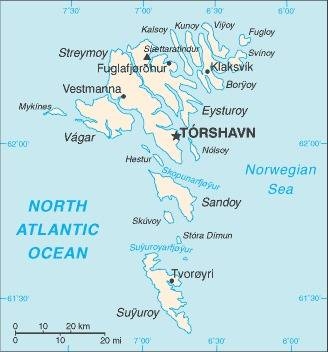Country Summary




Introduction
Background
The population of the Faroe Islands is largely descended from Viking settlers who arrived in the 9th century. The islands have been connected politically to Denmark since the 14th century.
Geography
Area
total: 1,393 sq km
land: 1,393 sq km
water: 0 sq km
Climate
mild winters, cool summers; usually overcast; foggy, windy
Natural resources
fish, whales, hydropower, possible oil and gas
People and Society
Population
52,269 (2022 est.)
Ethnic groups
Faroese 85.3% (Scandinavian and Anglo-Saxon descent), Danish 8.3%, other Nordic 1.4%, other 4.5% (includes Filipino, Poland, Romanian) (2022 est.)
Languages
Faroese 93.8% (derived from Old Norse), Danish 3.2%, other 3% (2011 est.)
Religions
Christian 89.3% (predominantly Evangelical Lutheran), other 1%, none 3.8%, unspecified 6% (2011 est.)
Population growth rate
0.63% (2022 est.)
Government
Government type
parliamentary democracy (Faroese Parliament); part of the Kingdom of Denmark
Capital
name: Torshavn
Executive branch
chief of state: Queen MARGRETHE II of Denmark (since 14 January 1972), represented by High Commissioner Lene Moyell JOHANSEN, chief administrative officer (since 15 May 2017)
head of government: Prime Minister Bardur A STEIG NIELSEN (since 16 September 2019)
Legislative branch
description: unicameral Faroese Parliament or Logting (33 seats; members directly elected in a single nationwide constituency by proportional representation vote; members serve 4-year terms)
the Faroe Islands elect 2 members to the Danish Parliament to serve 4-year terms
Economy
Economic overview
high-income Danish territorial economy; party neither to the EU nor the Schengen Area; associate Nordic Council member; very low unemployment; unique foreign ownership allowance in fishing industry; known salmon exporter; growing IT industries
Real GDP (purchasing power parity)
$2.001 billion (2014 est.)
Real GDP per capita
$40,000 (2014 est.)
Agricultural products
potatoes, mutton, sheep skins, sheep offals, beef, sheep fat, cattle offals, cattle hides, cattle fat
Industries
fishing, fish processing, tourism, small ship repair and refurbishment, handicrafts
Exports
$1.184 billion (2016 est.)
Exports - partners
Russia 26.4%, UK 14.1%, Germany 8.4%, China 7.9%, Spain 6.8%, Denmark 6.2%, US 4.7%, Poland 4.4%, Norway 4.1% (2017)
Exports - commodities
fish and fish products (97%) (2017 est.)
Imports
$978.4 million (2016 est.)
Imports - partners
Denmark 33%, China 10.7%, Germany 7.6%, Poland 6.8%, Norway 6.7%, Ireland 5%, Chile 4.3% (2017)
Imports - commodities
goods for household consumption, machinery and transport equipment, fuels, raw materials and semi-manufactures, cars
Exchange rates
Danish kroner (DKK) per US dollar -
Page last updated: Wednesday, May 11, 2022
